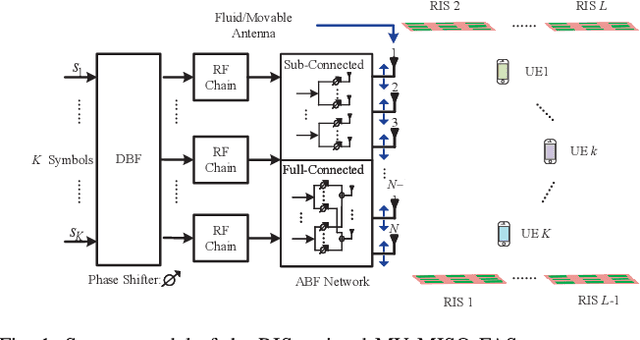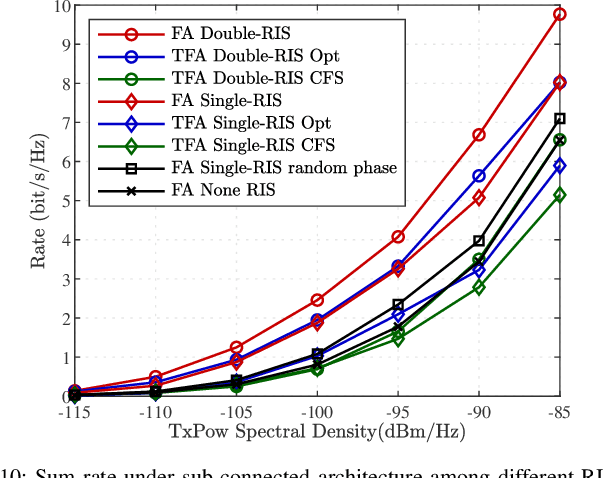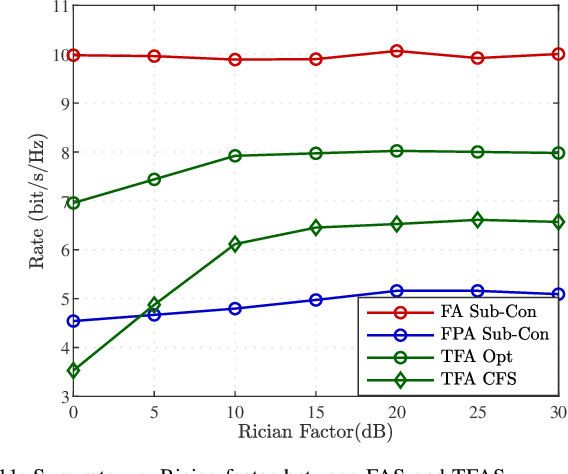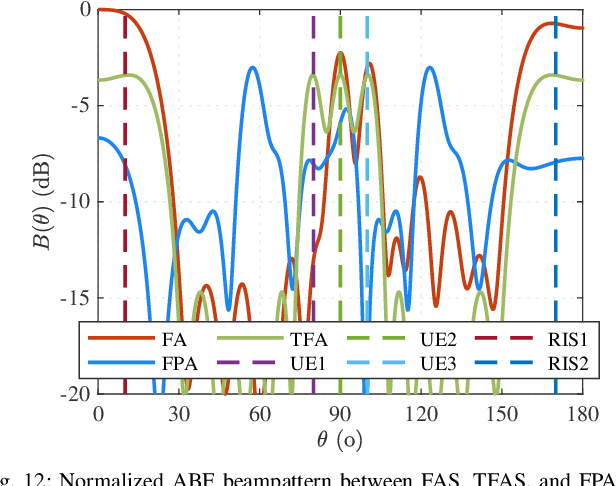Xia Lei
Integrated Sensing and Communication with Tri-Hybrid Beamforming Across Electromagnetically Reconfigurable Antennas
Oct 16, 2025Abstract:Beamforming with a sufficient number of antennas is one of the most significant technologies for both Multi-user (MU) Multiple-input Multiple-output (MIMO) communication and MIMO radar sensing in Integrated Sensing and Communication (ISAC) systems. However, its performance suffers from limited Degrees of Freedom (DoFs) in conventional hybrid beamforming systems. To overcome this, we propose an Electromagnetically Reconfigurable Antenna (ERA)-aided ISAC system, where transmit ERAs dynamically adjust their radiation patterns to enhance system DoFs and improve overall performance. Specifically, we design a tri-hybrid beamforming optimization framework combining digital, analog, and Electromagnetic (EM) beamforming to jointly maximize communication rate and sensing Signal-to-Clutter-plus-Noise Ratio (SCNR). Furthermore, an integrated Fractional Programming (FP) and Manifold Optimization (MO) approach is developed to transform the problem into tractable subproblems with closed-form updates. Simulation results verify that the proposed ERA-ISAC system achieves almost 10 dB Sensing and Communication (S&C) performance gain compared to its conventional hybrid beamforming counterparts with Omnidirectional Antenna (OA).
A Modular Algorithm for Non-Stationary Online Convex-Concave Optimization
Sep 09, 2025Abstract:This paper investigates the problem of Online Convex-Concave Optimization, which extends Online Convex Optimization to two-player time-varying convex-concave games. The goal is to minimize the dynamic duality gap (D-DGap), a critical performance measure that evaluates players' strategies against arbitrary comparator sequences. Existing algorithms fail to deliver optimal performance, particularly in stationary or predictable environments. To address this, we propose a novel modular algorithm with three core components: an Adaptive Module that dynamically adjusts to varying levels of non-stationarity, a Multi-Predictor Aggregator that identifies the best predictor among multiple candidates, and an Integration Module that effectively combines their strengths. Our algorithm achieves a minimax optimal D-DGap upper bound, up to a logarithmic factor, while also ensuring prediction error-driven D-DGap bounds. The modular design allows for the seamless replacement of components that regulate adaptability to dynamic environments, as well as the incorporation of components that integrate ``side knowledge'' from multiple predictors. Empirical results further demonstrate the effectiveness and adaptability of the proposed method.
Hybrid Beamforming for RIS-Assisted Multiuser Fluid Antenna Systems
Apr 12, 2025



Abstract:Recent advances in reconfigurable antennas have led to the new concept of the fluid antenna system (FAS) for shape and position flexibility, as another degree of freedom for wireless communication enhancement. This paper explores the integration of a transmit FAS array for hybrid beamforming (HBF) into a reconfigurable intelligent surface (RIS)-assisted communication architecture for multiuser communications in the downlink, corresponding to the downlink RIS-assisted multiuser multiple-input single-output (MISO) FAS model (Tx RIS-assisted-MISO-FAS). By considering Rician channel fading, we formulate a sum-rate maximization optimization problem to alternately optimize the HBF matrix, the RIS phase-shift matrix, and the FAS position. Due to the strong coupling of multiple optimization variables, the multi-fractional summation in the sum-rate expression, the modulus-1 limitation of analog phase shifters and RIS, and the antenna position variables appearing in the exponent, this problem is highly non-convex, which is addressed through the block coordinate descent (BCD) framework in conjunction with semidefinite relaxation (SDR) and majorization-minimization (MM) methods. To reduce the computational complexity, we then propose a low-complexity grating-lobe (GL)-based telescopic-FAS (TFA) with multiple delicately deployed RISs under the sub-connected HBF architecture and the line-of-sight (LoS)-dominant channel condition, to allow closed-form solutions for the HBF and TFA position. Our simulation results illustrate that the former optimization scheme significantly enhances the achievable rate of the proposed system, while the GL-based TFA scheme also provides a considerable gain over conventional fixed-position antenna (FPA) systems, requiring statistical channel state information (CSI) only and with low computational complexity.
Sensing-Resistance-Oriented Beamforming for Privacy Protection from ISAC Devices
Apr 08, 2024



Abstract:With the evolution of integrated sensing and communication (ISAC) technology, a growing number of devices go beyond conventional communication functions with sensing abilities. Therefore, future networks are divinable to encounter new privacy concerns on sensing, such as the exposure of position information to unintended receivers. In contrast to traditional privacy preserving schemes aiming to prevent eavesdropping, this contribution conceives a novel beamforming design toward sensing resistance (SR). Specifically, we expect to guarantee the communication quality while masking the real direction of the SR transmitter during the communication. To evaluate the SR performance, a metric termed angular-domain peak-to-average ratio (ADPAR) is first defined and analyzed. Then, we resort to the null-space technique to conceal the real direction, hence to convert the optimization problem to a more tractable form. Moreover, semidefinite relaxation along with index optimization is further utilized to obtain the optimal beamformer. Finally, simulation results demonstrate the feasibility of the proposed SR-oriented beamforming design toward privacy protection from ISAC receivers.
 Add to Chrome
Add to Chrome Add to Firefox
Add to Firefox Add to Edge
Add to Edge